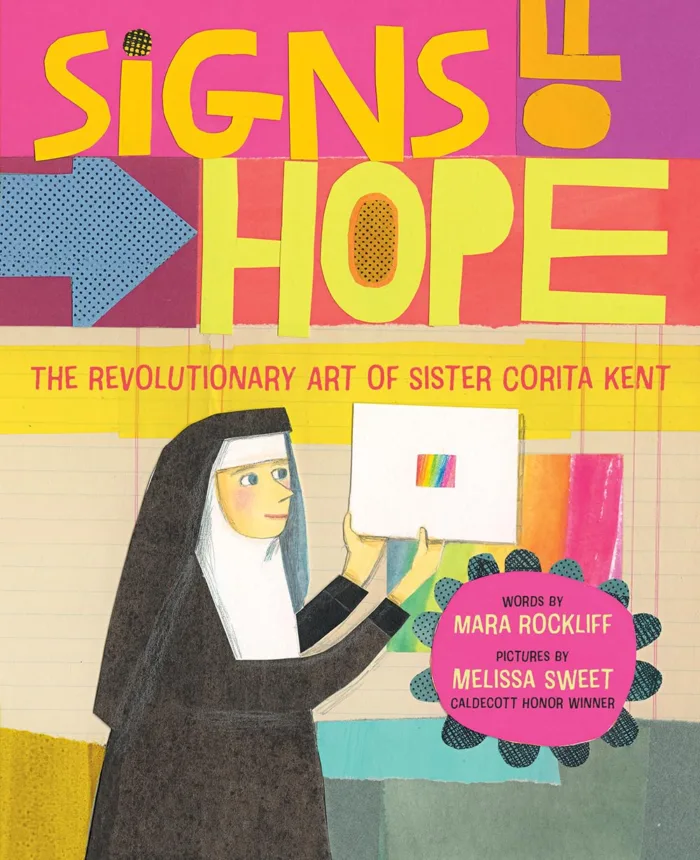Sister Corita Kent, born Frances Elizabeth Kent, was an American artist, educator, and Roman Catholic nun. She was born in 1918 in Fort Dodge, Iowa, and entered the religious order of the Sisters of the Immaculate Heart of Mary in Los Angeles in 1936. Kent is best known for her vibrant and socially conscious serigraphs (also known as silkscreen prints) that she created during the 1960s and 1970s.
Kent’s artwork often featured bold colors, playful typography, and excerpts from literature, advertising slogans, and song lyrics. Her art was deeply influenced by the pop art movement and reflected her concerns about social justice, civil rights, and the Vietnam War. Kent believed that art should be accessible to all and used her work to promote messages of love, peace, and hope.
In addition to her work as an artist, Kent was also a respected educator. She taught art at Immaculate Heart College in Los Angeles from 1947 to 1968 and was known for her innovative teaching methods and her ability to inspire her students.
Kent’s work has been exhibited in museums and galleries worldwide and has impacted the art world. She passed away in 1986, but her art and her message of hope continue to inspire people today.
Who Will Love This Book?
“Signs of Hope: The Revolutionary Art of Sister Corita Kent” by Mara Rockliff is a book that will resonate with a wide range of readers.
- Art Enthusiasts: Those interested in art history, especially the pop art movement of the 1960s and 1970s, will appreciate the detailed exploration of Sister Corita Kent’s life and work.
- Social Activists: People passionate about social justice and activism will find inspiration in Kent’s use of art to express her beliefs and advocate for change.
- Spiritual Seekers: Individuals interested in the intersection of art and spirituality will be drawn to Kent’s unique perspective as a nun whose art was deeply influenced by her faith.
- Educators: Teachers and educators will find Kent’s innovative teaching methods and her impact on her students’ lives to be particularly compelling.
- Fans of Biographies: Readers who enjoy biographies that explore the lives of fascinating individuals who have made significant contributions to their fields will find this book engaging and enlightening.
Overall, “Signs of Hope” is a book that will appeal to anyone interested in the power of art to inspire, provoke thought, and effect social change.
What Age Group is Best for “Signs of Hope?”
“Signs of Hope: The Revolutionary Art of Sister Corita Kent” by Mara Rockliff is suitable for readers of various ages, depending on their interests and reading level.
- Young Adults and Adults: The book’s content, which delves into art history, social justice, and spirituality, is likely to be most appreciated by young adults and adults who can grasp the historical and cultural context of Sister Corita Kent’s work.
- Teenagers: Older teenagers who are interested in art, activism, or history may also find the book engaging and accessible.
- Educators and Students: The book could also be a valuable resource for educators and students studying art history, social movements, or spirituality.
While younger readers may find some of the themes and concepts in the book challenging, older readers are likely to appreciate the depth and richness of the content. Overall, “Signs of Hope” is a book that readers of various ages can enjoy with an interest in the subject matter.
What Genre is This Book?
“Signs of Hope: The Revolutionary Art of Sister Corita Kent” by Mara Rockliff falls into several genres:
- Biography: The book explores the life and work of Sister Corita Kent, providing a detailed account of her journey as an artist and activist.
- Art: The book delves into the artistic techniques and themes of Sister Corita Kent’s work, making it of interest to those interested in art history and criticism.
- History: The book is set against the backdrop of the 1960s and 1970s, providing insight into the cultural and political context of Kent’s art.
- Social Justice: The book explores Kent’s activism and her use of art as a tool for promoting social change, making it relevant to readers interested in social justice issues.
Overall, “Signs of Hope” can be considered a blend of biography, art, history, and social justice, offering a comprehensive look at the life and work of Sister Corita Kent.

